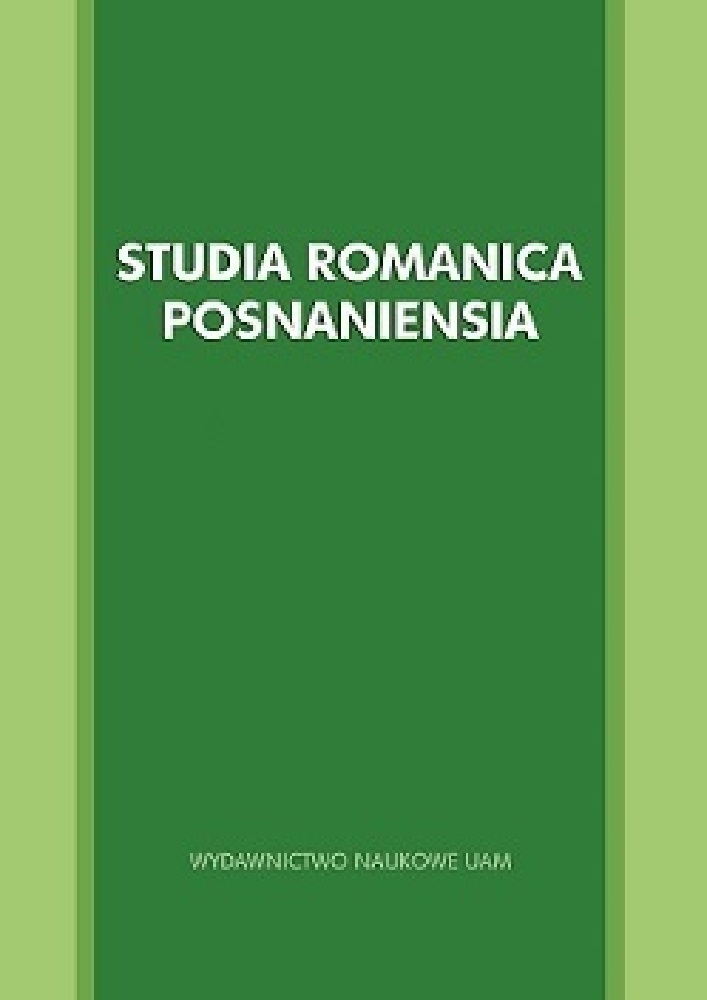Abstrakt
The aim of this paper is to demonstrate the feasibility of applying the Invited Inferencing Theory of Se- mantic Change in order to establish the semantic evolution of idioms with literal correlates, in particular somatisms or kinegrams. The methodology is applied to analyze the testimonies (until 1700) of Spanish somatism cerrar los ojos in a diachronic corpus of Spanish language (CORDE), so as to find out what inferences generated contextual meanings that conditioned its lexicalization as idiom, semanticizing symbolic meanings related to death, sleep, knowledge, irrationality, submission or trust.
Bibliografia
Bartsch, R. (1984). Norms, tolerance, lexical change, and context-dependent meaning. Journal of Pragmatics, 8, 367-393.. DOI: https://doi.org/10.1016/0378-2166(84)90029-8
Burger, H. (2007). Semantic aspects of phrasemes. In H. Burger, D. Dobrovol’skij, P. Kühn & N.R. Norrick (eds.), Phraseology: An International Handbook of Contemporary Research. Volume 1 (pp. 90-109). Berlín-Nueva York: Gruyter. DOI: https://doi.org/10.1515/9783110171013.90
CORDE = RAE (s. a.). Banco de datos CORDE: Corpus diacrónico del español. corpus.rae.es/cordenet.html.
Croft, W. (2000). Explaining Language Change: An Evolutionary Approach. Harlow: Longman-Pearson. Deumert, A. (2003). Bringing speakers back in? Epistemological reflections on speaker-oriented ex- planations of language change. Language Sciences, 25, 15-76. DOI: https://doi.org/10.1016/S0388-0001(01)00014-6
DLE = RAE & ASALE (2014). Diccionario de la lengua española (23ª ed.). https://dle.rae.es.
Grice, P. (1989 [1975]). Logic and Conversation. In P. Grice, Studies in the Way of Words (pp. 22-40). Cambridge-Londres: Harvard University Press.
Heine, B. (1994). Grammaticalization as an Explanatory Parameter. In W. Pagliuca (ed.), Perspectives on Grammaticalization (pp. 255-287). Amsterdam-Philadelphia: John Benjamins. DOI: https://doi.org/10.1075/cilt.109.08hei
Horn, L.R. (1984). Toward a new taxonomy for pragmatic inference: Q-based and R-based implicature. In D. Schiffrin (ed.), Meaning, Form, and Use in Context: Linguistic Applications (pp. 11-42). Washington: Georgetown University Press.
Levinson, S.C. (2000). Presumptive Meanings: The Theory of Generalized Conversational Implicature. Cambridge: MIT Press. DOI: https://doi.org/10.7551/mitpress/5526.001.0001
Lewandowska-Tomaszczyk, B. (1985). On semantic change in a dynamic model of language. In J. Fisiak (ed.), Historical Semantics: Historical Word-formation (pp. 297-323). Berlín-Nueva York-Amsterdam: Mouton. DOI: https://doi.org/10.1515/9783110850178.297
Lewis, C.T. & Short, C. (1879). A Latin Dictionary. Oxford: Clarendon Press. http://www.perseus.tufts.edu/hopper/text?doc=Perseus%3atext%3a1999.04.0059.
Martínez Kleiser, L. (1953). Refranero general ideológico español. Madrid: Hernando.
Ruiz Gurillo, L. (2010). Interrelaciones entre gramaticalización y fraseología en español. Revista de Filología Española, XC, 173-194. DOI: https://doi.org/10.3989/rfe.2010.v90.i1.201
Sánchez-López, E. (2021). El significado de las locuciones somáticas y su elaboración discursiva. eHumanista/IVITRA, 19, 421-439. https://www.ehumanista.ucsb.edu/sites/default/files/sitefiles/ivitra/volume19/05.%20Sa%CC%81nchez.pdf.
Traugott, E.C. (2010). (Inter)subjectivity and (inter)subjectification: A reassessment. In K. Davidse, L. Vandelanotte & H. Cuyckens (eds.), Subjectification, Intersubjectification and Grammaticalization (pp. 29-71). Berlín-Nueva York: Mouton de Gruyter. DOI: https://doi.org/10.1515/9783110226102.1.29
Traugott, E.C. (2012). Pragmatics and language change. In K. Allan & K.H. Jaszczolt (eds.), The Cambridge Handbook of Pragmatics (pp. 549-565). Cambridge: Cambridge University Press. DOI: https://doi.org/10.1017/CBO9781139022453.030
Traugott, E.C. & Dasher, R.B. (2002). Regularity in Semantic Change. Cambridge: Cambridge University Press. DOI: https://doi.org/10.1017/CBO9780511486500
Licencja
Prawa autorskie (c) 2023 Xavier Pascual-López

Utwór dostępny jest na licencji Creative Commons Uznanie autorstwa – Użycie niekomercyjne – Na tych samych warunkach 4.0 Międzynarodowe.
- Autor oświadcza, że przysługują mu osobiste i majątkowe prawa autorskie do Utworu oraz że nie są one ograniczone w zakresie objętym niniejszą Umową, oraz że utwór jest dziełem oryginalnym i nie narusza majątkowych lub osobistych praw autorskich innych osób.
- Autor udziela Uniwersytetowi im. Adama Mickiewicza w Poznaniu niewyłącznej i nieodpłatnej licencji na korzystanie z Utworu bez ograniczeń terytorialnych i przez czas nieokreślony na następujących polach eksploatacji:
2.1. wytwarzanie określoną techniką egzemplarzy Utworu, w tym techniką drukarską, reprograficzną, zapisu magnetycznego oraz techniką cyfrową;
2.2. wprowadzanie do obrotu, użyczenie lub najem oryginału albo egzemplarzy Utworu;
2.3. publiczne wykonanie, wystawienie, wyświetlenie, odtworzenie oraz nadawanie i reemitowanie, a także publiczne udostępnianie Utworu w taki sposób, aby każdy mógł mieć do niego dostęp w miejscu i w czasie przez siebie wybranym;
2.4. włączenie Utworu w skład utworu zbiorowego;
2.5. wprowadzanie Utworu w postacie elektronicznej na platformy elektroniczne lub inne wprowadzanie Utworu w postaci elektronicznej do Internetu, Intranetu, Extranetu lub innej sieci;
2.6. rozpowszechnianie Utworu w postaci elektronicznej w Internecie, Intranecie, Extranetu lub innej sieci, w pracy zbiorowej jak również samodzielnie;
2.7. udostępnianie Utworu w wersji elektronicznej w taki sposób, by każdy mógł mieć do niego dostęp w miejscu i w czasie przez siebie wybranym, w szczególności za pośrednictwem Internetu, Intranetu, Extranetu lin innej sieci;
2.8. udostępnianie Utworu zgodnie z wzorcem licencji Attribution-NonCommercial-ShareAlike 4.0 International (CC BY-NC-SA 4.0) lub innej wersji językowej tej licencji lub którejkolwiek późniejszej wersji tej licencji, opublikowanej przez organizację Creative Commons. - Autor zezwala Uniwersytetowi im. Adama Mickiewicza w Poznaniu na:
3.1. nieodpłatne korzystanie i rozporządzanie prawami do opracowań Utworu i tymi opracowaniami.
3.2. wysyłanie metadanych Utworu oraz Utworu do komercyjnych i niekomercyjnych baz danych indeksujących czasopisma. - Autor upoważnia i zobowiązuje Uniwersytet im. Adama Mickiewicza w Poznaniu do udzielania osobom trzecim dalszych licencji (sublicencji) do Utworu oraz do innych materiałów, w tym utworów zależnych lub opracowań zawierających lub powstałych w oparciu o Utwór, przy czym postanowienia takich sublicencji będą tożsame z wzorcem licencji Attribution-NonCommercial-ShareAlike 4.0 International (CC BY-NC-SA 4.0) lub innej wersji językowej tej licencji lub którejkolwiek późniejszej wersji tej licencji, opublikowanej przez organizację Creative Commons Tym samym uprawnia wszystkich zainteresowanych do korzystania z utworu wyłącznie w celach niekomercyjnych pod następującymi warunkami:
4.1. uznanie autorstwa czyli obowiązek podania wraz z rozpowszechnionym utworem informacji, o autorstwie tytule, źródle (odnośniki do oryginalnego utworu, doi) oraz samej licencji;
4.2. na tych samych warunkach, wolno rozpowszechniać utwory zależne jedynie na licencji identycznej to tej, na jakiej udostępniono utwór oryginalny. - Uniwersytet im. Adama Mickiewicza w Poznaniu jest zobowiązany do:
5.1. udostępniania Utworu w taki sposób, aby każdy mógł mieć do niego dostęp w miejscu i w czasie przez siebie wybranym bez ograniczeń technicznych;
5.2. poprawnego informowania osób, którym Utwór będzie udostępniany o udzielonych im sublicencjach w sposób umożliwiający odbiorcom zapoznanie się z nimi.
Pozostałe postanowienia
- Uniwersytet im. Adama Mickiewicza w Poznaniu zachowuje prawo do czasopisma jako całości (układ, forma graficzna, tytuł, projekt okładki, logo itp.).

